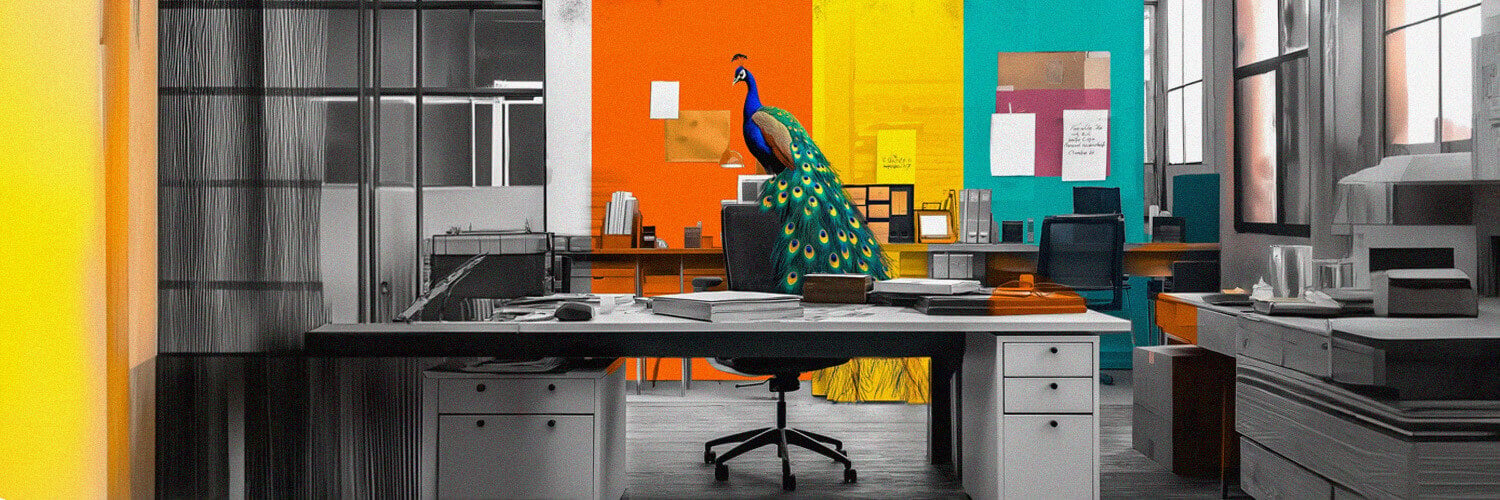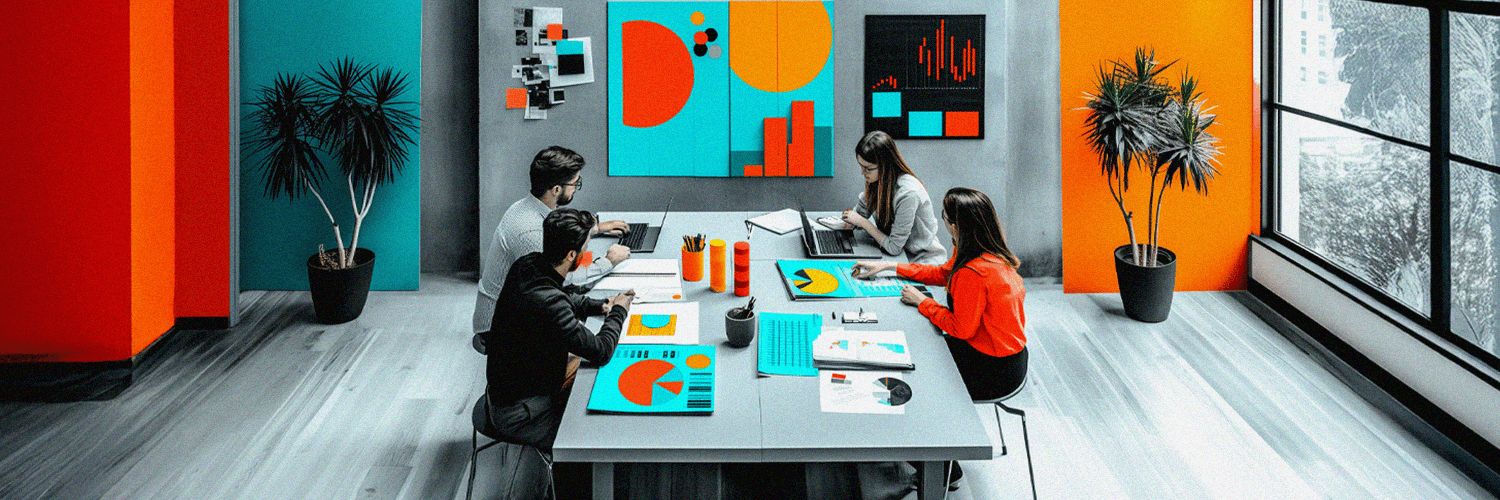62% of employees would agree to a pay cut of 10% in exchange for a work-from-anywhere policy. Or for a hybrid model.
So the question that arises is:
How can you make your return-to-office strategy solid enough to compete with the lure of working from home?
Enter office peacocking: companies trying to lure employees back to the office with more comfortable and homey feeling and looking offices, stocked kitchens, biophilic design, and… more!
But is adopting this trend alone – adding amenities and upgrading the office decor – enough to want to return to the office?
And not just for coffee badging…
Let’s dive into this a bit deeper and find out:
- What office peacocking is
- What motivates companies to jump on this trend
- What challenges to expect when implementing your office peacocking strategy
- How technology can help you add real value to the workplace experience
TL;DR:
- Office peacocking is a strategy to lure employees back to the office by enhancing workspace appeal.
- Motivations include boosting productivity, well-being, and reinforcing company culture.
- Challenges include managing costs and avoiding superficial changes that lack real value.
- Small businesses can adapt by focusing on meaningful, budget-friendly upgrades.
- Success depends on aligning office changes with employees' deeper needs and workplace experiences.
What Is Office Peacocking?
Office peacocking is a strategic move to bring employees back to the office by making the office environment more attractive.
And offering them (more) meaningful in-office experiences.
It involves enhancing the workspace with carefully selected furniture – both stylish and irresistibly ergonomic – biophilic design touches and state-of-the-art technologies.
… And it goes all the way to offering employees healthy food options and different wellness facilities.
In short, the peacocking trend that we’re witnessing rising in the workplace in 2024 incorporates all the tactics companies adopt to counter the convenience of working from home.
And to turn the office into a space people want to come to. More often.
The Concept's Emergence in the Modern Workplace
The practice of “office peacocking” has emerged in the modern office landscape as companies have been striving to bring employees back to the office post-pandemic.
It’s been around for 4 years, but it seems to be on the rise in 2024.
With many companies trying to force return-to-office mandates, then being challenged to rethink their strategies – as they faced employees’ pushback – office peacocking seems to be one of the return-to-office trends defying 2024’s work landscape.
One that reshapes the office space – with fancy amenities and office perks that can only be unlocked in person – in an attempt to compete with the convenience of working remotely.

The Motivations Behind Office Peacocking
Now, let’s try to go deeper to understand why companies are doing this.
What are the main reasons why they’re turning this trend of transforming their workspaces into a huge phenomenon shaping the modern workplace:
Attracting Employees Back to the Physical Office
This is the main motivation behind office peacocking.
Companies are redesigning their workplaces to make them more appealing and more comfortable.
That’s the key rationale behind the standing desks, biophilic design touches, artsy lounge areas, and… wellness facilities incorporated into the office environment.
They’re all part of this strategic move of creating an office environment that makes employees genuinely want to come back to the office. Day after day.
Creating a Competitive Work Environment
Office peacocking is also all about redesigning the physical workspace so that it boosts productivity and drives innovation.
One that inspires employees to continuously improve, outperform, and… excel.
Promoting Employee Well-being and Satisfaction
These are 2 ripple effects of office peacocking.
Although the main motivation for making the physical workspace more appealing was to make employees want to come to work there – as often as possible – a well-designed one will automatically enhance employees’ well-being, too.
People-centric elements – like ergonomic furniture, natural light, and acoustic walls – reduce stress levels.
They improve the overall mental health and employee satisfaction.
And employees that feel happy working in that work environment will genuinely want to come back. Day after day.
Reinforcing Company Culture and Employee Identity
Companies are well aware that their (well-designed) physical work environment is a powerful tool for reinforcing company culture and employees' sense of belonging.
For boosting employee identity.
It’s where employees reconnect with company values.
Creating a Competitive Edge Through Workspace Design
An attractive and wellbeing-centric workspace helps companies stand out in a competitive job market.
Their focus on the overall employee experience – reflected in the physical work environment – can turn into a key deciding factor for new candidates.
For that top talent they’re trying to attract.
And for their current employees, too. As an inviting physical workplace – proof of a supportive office culture – can serve as an effective retention tool.

Examples of Office Peacocking in Action
Curious how specific companies have “peacocked” their own office spaces?
Here are 3 case studies to get inspired by:
Airbnb’s Office in San Francisco
It’s an office workspace that mimics some of Airbnb’s most popular listings. Globally.
With communal spaces that support collaboration and strengthen the sense of community.
The result?
The unique design inspires Airbnb employees to get (more) creative and makes them feel like they’re contributing to something special.
WeWork’s Coworking Office Spaces
The company approached the peacocking trend slightly… differently.
In its attempt to bring employees back to the office space, it has turned it into co-working environments.
Into flexible, modern, and visually pleasing spaces perfect for hosting community events and providing networking opportunities.
Google’s Head Office: Googleplex
Making and keeping employees happy and productive.
These are the 2 motivations behind Google’s office peacocking.
Their headquarters stand out as a cluster of office amenities – swimming pools, relaxation pods, fitness centers, gourmet cafeterias – aimed at attracting top talent.
And at making their most valued employees enjoy working there. On-site. Daily.
The Role of Technology in Office Peacocking
Beyond creating an amenity-rich and visually appealing workspace, you’ll want to design a workplace office that incorporates cutting-edge technology:
Interactive whiteboards, high-speed WI-FI, ergonomic workstations… and technology that enhances collaboration, and streamlines workflows.
Technology that facilitates seamless hybrid work.
Like Yarooms – the all-in-one workplace platform that enhances every aspect of the workplace experience – that gives your employees access to:
- an easy-to-use planning calendar to power their hybrid work
- workplace tools that grant them the level of autonomy, visibility, and flexibility they’re expecting to find at work
- a powerful workspace booking tool that automates the whole process and makes booking a parking lot, an office desk or a meeting room so much quicker. And easier.
Challenges and Criticisms of Office Peacocking
Because yes, you should expect some concerns around the different tactics of office peacocking you’ll want to implement.
Here are the 3 most common challenges – and how to overcome them:
Managing the Costs of Elaborate Office Designs
All that high-end, comfortable furniture and modern decor does risk leaving a hole greater than planned into your budget.
How do you mitigate this potential drawback?
Simple! You weigh the benefits you’d gain from improving your workplace layout – increased efficiency and productivity, better retention level, boosted creativity and innovation – against the expenses.
Does the ROI justify the office peacocking costs?
Avoiding Superficial Changes That Lack Substance
Making flamboyant, superficial changes to your office design and environment, that bring no real value to the employees’ workplace experience, is probably one of the most common pitfalls of peacocking your office.
How do you avoid falling into it?
You put every “office peacocking” type of change you’re planning to make through the filter of THE deeper needs and real reasons why employees would want to come back to the office more often.
Reason like:
-
The opportunity to have more privacy in their workspaces
-
The ability to know, in advance, who’s coming to the office every day
-
The opportunity to maintain a high level of autonomy and a healthy work-life-balance
In other words, if the rationale behind that new ping pong table in the recreational room is not to enhance employees' well-being while at work, but to make them work longer hours, you’re only implementing a superficial change to your physical workplace.
As it doesn’t serve a deeper need your employees have.
Balancing Fun with Professionalism
In your attempt to create a (more) lively and engaging work environment, you run the risk of sabotaging even the very benefits you expect to reap from office peacocking.
Like productivity, efficiency, and… innovation.
As an overemphasis on “fun at work” does risk distracting your employees.
How do you prevent this from happening?
You make sure all those playful elements you incorporate into the office environment integrate, perfectly, into the office culture.
That they boost morale and… energize your employees rather than lower your professional standards and work ethic.

Adapting Office Peacocking for Small Businesses and Startups
What if you’re a small business/startup and you don’t yet have the budget for upgrading your office workplace with smart furniture, expensive artwork or an on-site fitness center… that feels like a high-end spa?
How can you still jump on this back-to-office trend and still benefit from “office peacocking”?
You adapt this strategic move to your business’s size and particularities.
And opt for tactics that are less flashy and flamboyant (and costly), but which still respond to employees’ deeper needs.
And expectations from a physical workplace.
For example, you can:
- Design a unique office space, that speaks of your brand’s (unique) identity – that no other company could replicate without sounding false (see Airbnb’s case example)
- Opt for flexible layouts and custom artwork
- Showcase team achievements and unique brand values
- Encourage employees to express their own creativity and personalities when customizing their own workspaces
The result?
You’ll boost your employees’ morale – with a ripple effect on their efficiency, productivity, and creativity – stand out from your competitors and catch the attention of the right type of top talent you’re trying to attract
And people do want to be in an office space where their creative expression is encouraged. Day by day.
Wrapping Up: Is Office Peacocking A Strategic Move or Superficial Tactic?
It depends on your deeper rationale of why you’d want to transform your workspace:
- To impress your employees?
- Or to add value to their workplace experience?
Probably the most effective way to ensure that each peacocking change you make is an impactful improvement and not just a superficial tactic is to ask them.
To ask your employees what would make them want to come to the office more often.
Or, what is it that they miss in the physical workspace.
And no, people won’t trade the convenience of working from home for a… designer chair. Or an expensive artwork.
But they might trade their kitchen chair for a perfectly ergonomic, irresistibly comfortable one paired with the chance to have their favorite colleagues working near their desks. desks.
Or for the chance to attend in-person training that fits their career and personal growth goals.











